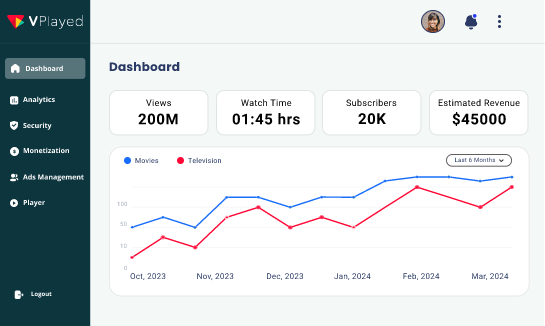Which Streaming Protocol to Sort out for your Streaming Solution – A Rival between RTMP & HLS

With the ever flourishing video on demand technology which has a massive market value of around US $14,042M in 2018 and expected to hit 9.9% in 2022. VOD platform and live streaming are getting off in crazy, where businesses are carried with live streaming technology to provide HD-pixel rate content on-the-go. Video streaming entails a significant transmitting protocol to deliver superlative content seamlessly.
Streaming protocols play the crucial role in transmitting data and controlling the server to deliver the best of it. Choosing the ideal and most popular streaming protocol that is appropriate to your server is one of the arduous and bewildering states that we see from aspiring newcomers into the live streaming. To resolve these kinds of bewildering, we have made a rival between RTMP and HLS to bring out which perfectly suits to pick your streaming Protocol.
Table of Contents
The Rival Between RTMP and HLS
“This isn’t about Either or Choice, it’s an absolute advantage of both the Protocols.”
Before getting into, let us have a quick glance about the most common streaming protocol which has been used for live video streaming.
What is all about Media Streaming Protocol?
The Media Protocol establishes and takes control of the media stream between a server and client device to synchronize the media such as audio and video on a real-time basis. It also serves as a remote network controller.
To put it simply, the most digital video protocol is designed for two main things, Storage and Playback. The video files aren’t simply transmitting, they are cut into chunks and sent sequentially to deliver the highest quality of video to the user with the use of adaptive bitrate protocols.
Real-Time Messaging Protocol (RTMP)
The Real-Time Messaging Protocol is developed by Macromedia, owned by Adobe which is widely used for streaming audio and video over the use of the Internet. This has been considered as the best option and fallback protocol compared to other technologies. The RTMP has the minimal latency among other protocols and it’s also dependent on a flash plugin which requires HTL streaming protocol to transmit the video through CDN. Real-Time Messaging Protocol is featured with a Multi-platform streaming protocol which supports for Mac, iOS and Windows.
The Edges of utilizing the peerless Real-Time Messaging Protocol
- 1. The actual installation process of a Flash Media Server is simple, effective and appears to be trustworthy since the protocol was established 10 years back.
- 2. RTMP has an exceptional feature where it provides low latency while transmitting live broadcasts.
- 3. The protocol has the potentiality to transmit audio and video on any formats and rendition.
- 4. It also supported universally due to its effectiveness in implementing for live streaming.
The Pitfalls that influences the performance in using RTMP
- 1. It does not have native support in iOS.
- 2. RTMP does not work in HTML5, it differs from the HTTP Protocol.
- 3. The security of delivering video is minimal.
Who has the necessity to use RTMP?
Since the RTMP provides low latency streams, considered in using this for streaming to a huge size of the audience. It also requires a Flash Plugin which is not much recommended but the exception always for its stream ingestion. The solution is perfect for sharing and streaming to use between clients having the flash plugin.
HTTP Live Streaming Protocol (HLS)
HLS is also known as HTTP Live streaming which is HTTP-based media sharing communication protocol. The protocol is developed by Apple Inc. The most widely used protocol which is supported on all platforms including Smart TVs, browsers, Web, iOS and Android mobile devices. HLS support adaptive bitrate streaming which helps in delivering the best video quality. Due to the recent update to support 265 codec assist in delivering twice the quality of video at the same file size.
The Edges that thrives the influence of making to HLS
- 1. HLS is a pocket-friendly protocol which is Compatible on all the platforms and supports HTML5/HLS video player.
- 2. Helps to stream to reach more viewers and also the safest protocol to scale up the content to a massive base audience.
- 3. The biggest advantage of HLS is that it has the potentiality to deliver adaptive bitrate streaming where the quality of the content to be expected at a high pixel-rate.
The Stumbling blocks that hitches while making use of HLS
- 1. HLS has latency which is relatively high when compared to RTMP.
- 2. The performance of HLS on other platforms is minimal when compared to the performance on iOS only.
Who has the necessity to use HLS?
This protocol is absolutely ideal for those businesses who wish to deliver the content to a massive number of audience at best quality. To experience the safest streaming of video content to a large audience.
So, finally, the Protocol to Go
Contus Vplayed, being as the most successful video on demand solution in providing customized video platform to the global clients, we recommend making it simple. It’s much absorbed that many users go with HLS to deliver superlative content to reach a large number of audience, but RTMP provides the result with minimal latency with the use of Flash Plugin. Some users spot that RTMP is better for their video streaming platform. However, both the protocols are quite outstanding when it comes to the performance in delivering an immense experience to its audience.
If you are still not quite clear in choosing the best video streaming protocol to your online video platform, Get it touch with our technical experts. We’ll help you with it.




